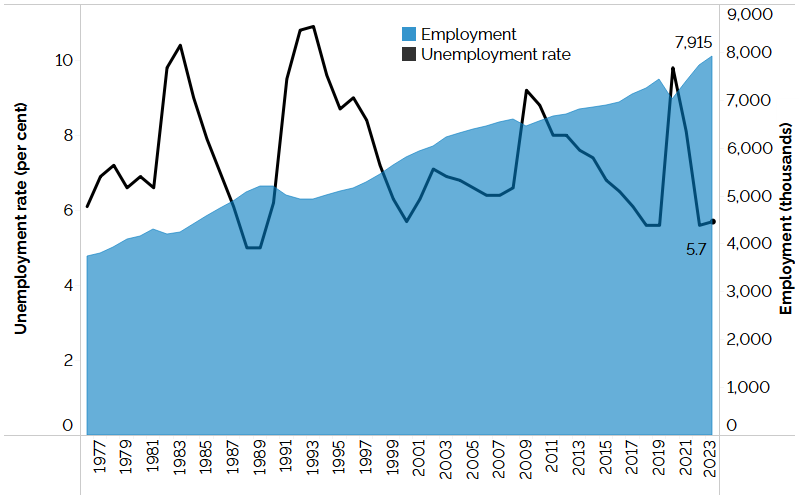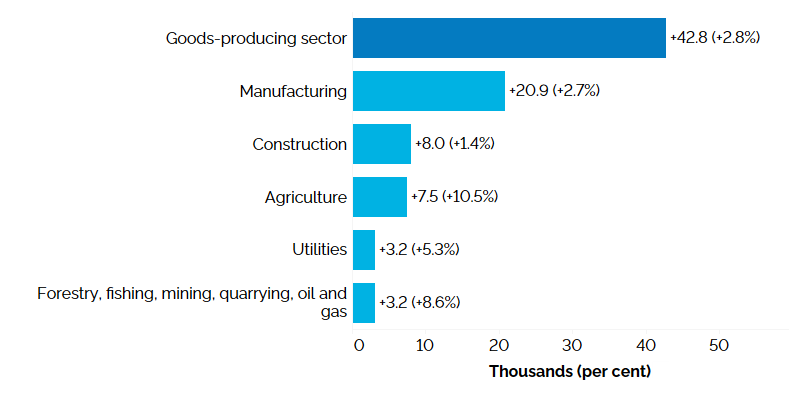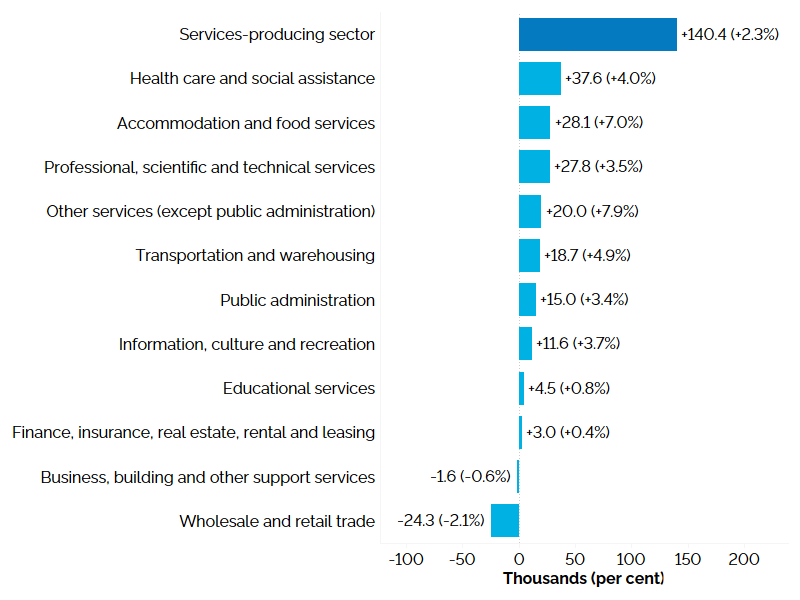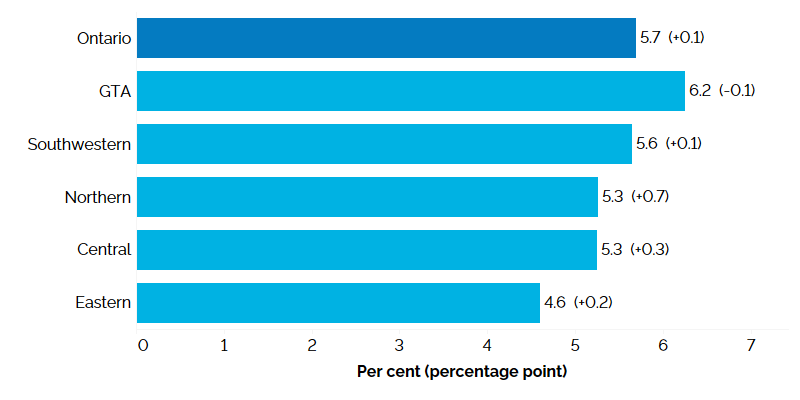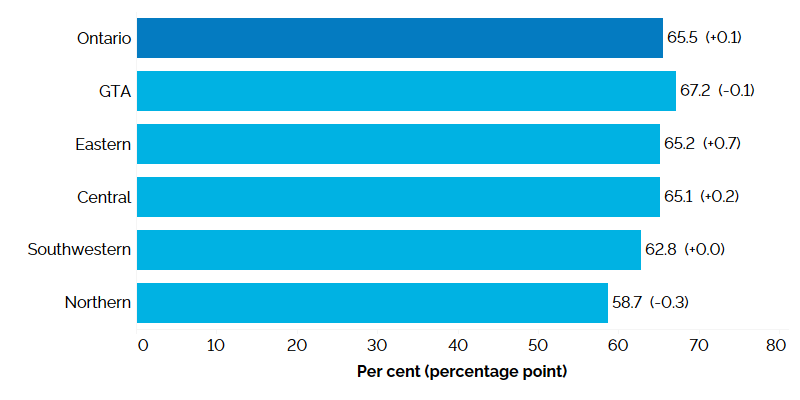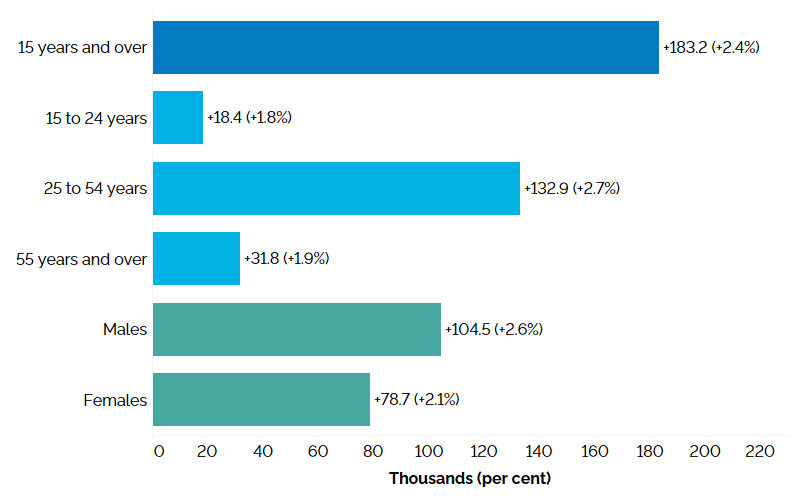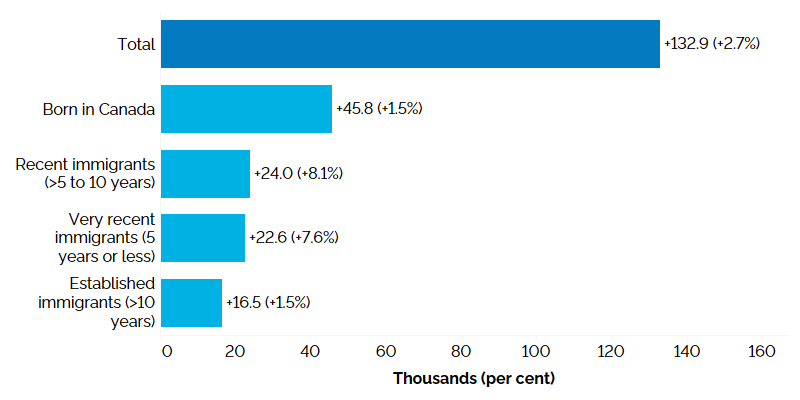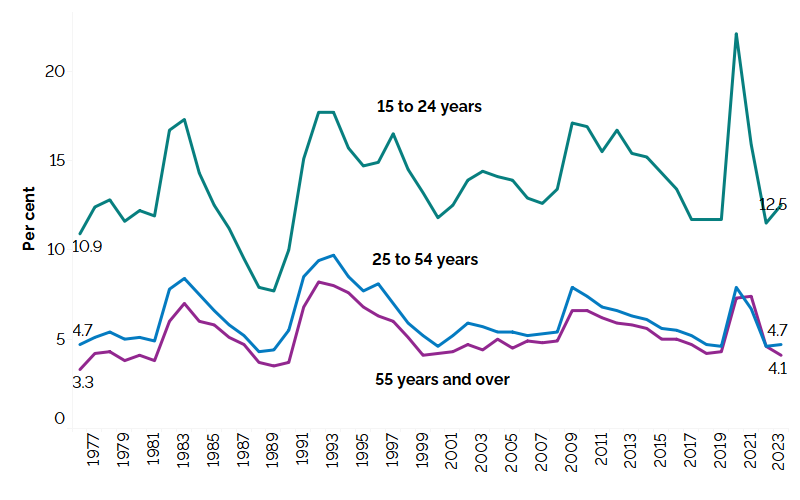January to December, 2023
Introduction
About the Ontario Employment Report – January to December, 2023
The Ontario Employment Report is released four times a year and provides an assessment of the current trends and developments in the Ontario labour market. The Ontario Employment Report is a companion report to the Ontario Economic Accounts, which provides an overall assessment of the current state of the Ontario economy.
The report for the fourth quarter of 2023 provides an assessment of Ontario’s labour market for the entire year, comparing annual averages, while the first through third quarter reports measure year-over-year changes in quarterly data.
Methodological note
In this report, year-over-year change represents change between 2022 and 2023. Longer-term trends are included for select labour market characteristics to provide historical context.
All estimates in the report are based on Statistics Canada’s Labour Force Survey (LFS), which measures the current state of the national, provincial and territorial labour market. The LFS is based on a household survey carried out monthly by Statistics Canada in reference weeks of the month. All estimates in this report include the population aged 15 years and over, unless otherwise indicated.
Overview
Key labour market indicators, 2023
Employment:
- +183,200 net jobs in 2023, year-over-year
- +169,800 net full-time jobs in 2023, year-over-year
Unemployment rate:
- 5.7% in 2023
Participation rate:
- 65.5% in 2023
Employment change by province, 2023
In 2023, Ontario’s employment increased by 2.4% (+183,200). This followed a notable increase in 2022 (+338,300, +5.2%) and the largest annual increase on record
Ontario’s labour market, 1976-2023
In 2023, the unemployment rate in Ontario was 5.7%, above the Canadian rate (5.4%) and the fifth lowest rate among provinces. In 2023, there was a slight increase in the unemployment rate (+0.1 percentage point), after the largest annual decrease on record in 2022 (-2.5 percentage points).
In 2023, the labour force participation rate in Ontario edged up by 0.1 percentage point to 65.5%, which was just below the Canadian rate (65.6%).
The employment rate remained steady at 61.8% in 2023, despite employment growth (+2.4%), as the population in the LFS also increased proportionally (+292,400, +2.3%). This represented the largest annual increase in the population in the LFS on record.
Highlights in 2023
- Employment increased among full-time workers (+2.7%) and part-time workers (+1.0%).
- The private sector (+3.3%) and public sector (+1.6%) experienced employment growth, while self-employment declined (-0.9%).
- Employment increased in both the services-producing (+2.3%) and goods-producing industries (+2.8%) with the largest increase in health care and social assistance, as well as accommodation and food services.
- Among broad occupational groups, management occupations and trades, transport and equipment operators and related occupations saw the largest increases in employment.
- Employment increased in four out of five regions, with Eastern Ontario (+3.0%) recording the highest percentage increase in employment, while employment in Northern Ontario edged down (-0.5%).
- Employment levels increased relatively more for those with a university degree (+4.2%) and those with a postsecondary certificate or diploma (+2.6%), while employment for those without a postsecondary education credential declined.
- Core-aged workers (+2.7%) experienced faster employment growth compared to youth and older workers.
- Actual average weekly hours worked per worker increased and the total economy-wide weekly hours worked were at their highest level since 1976.
- The average hourly wage of employees was $34.63, an increase of 1.3% after accounting for inflation.
Type of work
Employment change by full-time, part-time status, Ontario, 2023
In 2023, employment in Ontario increased by 2.4%, driven by increases in both full-time (+169,800, +2.7%) and part-time positions (+13,400, +1.0%).
Part-time employees experienced disproportionate job losses during the COVID-19 pandemic. In 2023, part-time employment was still 1.0% below its 2019 level, while full-time employment was 8.3% above its 2019 level.
Employment change by employment sector, Ontario, 2023
The private sector had the largest increase in employment (+168,800, +3.3%), followed by the public sector
In 2023, self-employment was still below its 2019 pre-pandemic level (-70,300, -6.1%), while both private sector and public sector employment exceeded their 2019 levels.
Industry and occupation
In 2023, employment increased in both goods-producing (+42,800, +2.8%) and services-producing (+140,400, +2.3%) industries.
Employment change by industry, goods-producing industries, Ontario, 2023
Among goods-producing industries, manufacturing recorded the highest employment growth (+20,900), followed by construction (+8,000), agriculture (+7,500), utilities (+3,200) and forestry, fishing, mining, quarrying, oil and gas (+3,200).
Employment change by industry, services-producing industries, Ontario, 2023
Most services-producing industries experienced employment growth in 2023. Health care and social assistance industries (+37,600) had the greatest net employment growth, followed by accomodation and food services (+28,100) and professional, scientific and technical services (+27,800). Wholesale and retail trade (-24,300) and business, building and other support services (-1,600) were the only services-producing industries that experienced declines in employment.
Employment change by occupational group, Ontario, 2023 footnote 3
Among broad occupational groups, management occupations (+66,600) saw the largest increase in employment followed by trades, transport and equipment operators and related occupations (+54,800) and business, finance and administration occupations (+34,900). Occupations in three broad occupational groups experienced a decline in employment, led by occupations in manufacturing and utilities (-12,700).
Regions
Employment change by region, Ontario, 2023
In 2023, all Ontario regions experienced employment growth, except for Northern Ontario (-0.5%). The Greater Toronto Area (GTA) experienced the largest employment increase (+100,000); however, Eastern Ontario experienced the greatest percentage increase in employment (+3.0%), followed by the GTA (+2.7%) and Central Ontario (+2.2%).
Unemployment rate by region, Ontario, 2023
In 2023, the unemployment rate increased in every region, except in the GTA (-0.1 percentage point). The GTA had the highest unemployment rate (6.2%) while Eastern Ontario had the lowest unemployment rate (4.6%).
Participation rate by region, Ontario, 2023
In 2023, the participation rate increased in two out of Ontario’s five regions. The GTA had the highest participation rate (67.2%), while Northern Ontario had the lowest participation rate (58.7%).
Demographic groups
Employment change by age group and gender, Ontario, 2023
In 2023, employment increased for all age groups and for both females and males. Males experienced greater employment gains (+104,500, +2.6%) than females (+78,700, +2.1%). Employment levels increased the most for core-aged workers aged 25 to 54 years (+132,900), while youth aged 15 to 24 years and older adults aged 55 years and over registered similar percentage increases in employment (+1.8% and +1.9%, respectively).
Employment change by education level, core-aged workers, Ontario, 2023
Among the core-aged population, employment increased for those with a postsecondary credential, driven by university graduates (+96,900 +4.2%) and those with a postsecondary certificate or diploma (+44,000, +2.6%). Those with a high school credential experienced the greatest decline in employment (-7,300, -0.8%).
Employment change by immigrant status, core-aged workers, Ontario, 2023
In 2023, both landed immigrants and those born in Canada experienced an increase in employment, with recent immigrants recording the greatest percentage increase in employment (+8.1%), followed by very recent immigrants (+7.6%), those born in Canada (+1.5%), and established immigrants (+1.5%).
Wages
Average hourly wages by employment status, Ontario, 1997-2023footnote 5
Over the last two and a half decades, the average hourly wage increased in real terms
Real hourly wage change by type of work, Ontario, 2023
In 2023, the average hourly wage of Ontario employees was $34.63 per hour, an increase of 5.1% or 1.3% in real terms (after accounting for inflation of 3.8%)
Real average wages increased by 1.5% for full-time employees and decreased by 0.9% for part-time employees in 2023. Real hourly wages of permanent workers increased by 1.5%, while those of temporary workers decreased by 1.4%. Real hourly wages of unionized employees decreased by 1.2%, while those of non-unionized employees increased by 2.2%.
Average hourly wage by occupational group, Ontario, 2023
In 2023, employees in management occupations had the highest average hourly wage ($59.75), followed by natural and applied sciences and related occupations ($45.82) and occupations in education, law and social, community and government services ($40.41). Employees in sales and service occupations had the lowest average hourly wage ($22.18).
Employment change by real hourly wage (constant 2023 dollars), Ontario, 2023
In 2023, employment of workers earning less than $20.00 per hour (measured in constant 2023 dollars) decreased by 8.9%, while employment of those earning between $20.00 and $39.99 per hour increased by 5.6% and employment of those earning $40.00 or more increased by 8.4%
Hourly wages by percentiles of earners (constant 2023 dollars), Ontario, 2006-2023 footnote 9
In 2023, the median hourly wage was $29.00, while 25% of employees earned an hourly wage of $43.27 or higher and 25% of employees earned an hourly wage of $20.19 or less. The top 10% of employees earned an hourly wage of at least $57.69, 3.5 times higher than the hourly wage earned by the bottom 10% of employees ($16.50). The ratio of the hourly wage earned by the 90th percentile (top 10%) to that earned by the 10th percentile (bottom 10%) declined from 4.2 in 2006 to 3.5 in 2023. This suggests a decline in hourly wage inequality and was likely in part caused by increases in minimum wages.
Hours Worked
Total weekly hours worked, Ontario, 1976-2023
In 2023, total weekly hours worked
Unemployment
Unemployment rate and change from previous year by province, 2023
In 2023, four provinces experienced a decline in their unemployment rate, and six provinces experienced an increase. Ontario’s unemployment rate edged up to 5.7%, 0.1 percentage point higher compared to 2022. Ontario had the fifth lowest unemployment rate among the ten provinces and was 0.3 percentage point above the Canadian rate of 5.4%. Quebec had the lowest unemployment rate (4.5%), and Newfoundland and Labrador had the highest (10.0%).
Unemployment rate by age group, Ontario, 1976-2023
In 2023, the unemployment rate increased for youth aged 15 to 24 years (+1.0 percentage point), edged up for the core-aged population aged 25 to 54 years (+0.1 percentage point) and decreased for the older population aged 55 years and over (-0.5 percentage point). Youth had the highest unemployment rate (12.5%), followed by the core-aged population (4.7%) and older population (4.1%).
Share of long-term unemployment, Ontario, 1976-2023
In 2023, long-term unemployment (unemployed for 27 weeks or more) as a share of total unemployment declined from a recent high of 28.2% in 2021 and 18.2% in 2022 to 16.7% in 2023.
The average duration of unemployment in 2023 was 17.6 weeks, 2.1 weeks lower than the average in 2022 (19.7 weeks).
Participation rates
Participation rate and change from previous year by province, 2023
In 2023, Ontario’s participation rate for people aged 15 years and over was 65.5%, an increase of 0.1 percentage point compared to 2022. The participation rate in Ontario was slightly below the Canadian average (65.6%) and ranked fifth out of the ten provinces. Ontario was one of the five provinces that had seen an increase in its participation rate in 2023, while the other provinces experienced a decline.
While Ontario’s participation rate has been on the decline since 2003, in part due to an aging population, recent increases have brought the rate back to the highest it has been since 2015. In 2023, there were 171,600 people who wanted work but were not part of the labour force, which is 5.1% more than in 2022, while the total labour force grew by 2.5%.
Participation rate by gender, Ontario, 1976-2023
In 2023, the participation rate of males edged up by 0.1 percentage point to 70.0% and was the same as the pre-pandemic rate in 2019. The participation rate of females stayed the same as in the previous year at 61.2% and was above the pre-pandemic rate of 60.8% in 2019.
Participation rate by age group, Ontario, 1976-2023
In 2023, the participation rate of the core-aged population increased by 0.4 percentage point to 88.3%, the highest it has been since 1976. The participation rate of youth decreased by 0.5 percentage point to 62.1% and was 0.4 percentage point below the pre-pandemic rate in 2019. The participation rate of the older population declined by 0.2 percentage point to 37.7% and was 1.0 percentage point below the pre-pandemic rate in 2019.
Appendix
10-year overview of annual employment
| - | 2014 | 2015 | 2016 | 2017 | 2018 | 2019 | 2020 | 2021 | 2022 | 2023 |
|---|---|---|---|---|---|---|---|---|---|---|
| Total Labour Force (000) | 7,384.8 | 7,386.4 | 7,442.7 | 7,576.3 | 7,679.4 | 7,866.6 | 7,788.0 | 8,048.8 | 8,190.4 | 8,392.6 |
| Participation Rate (%) | 66.0 | 65.5 | 65.2 | 65.3 | 64.9 | 65.3 | 63.7 | 65.2 | 65.4 | 65.5 |
| Male Participation Rate (%) | 70.6 | 70.4 | 69.9 | 70.0 | 69.6 | 70.0 | 68.6 | 69.9 | 69.9 | 70.0 |
| Female Participation Rate (%) | 61.6 | 60.8 | 60.6 | 60.7 | 60.5 | 60.8 | 59.1 | 60.7 | 61.2 | 61.2 |
| Total Employment (000) | 6,840.0 | 6,887.0 | 6,956.4 | 7,117.3 | 7,245.9 | 7,429.2 | 7,025.9 | 7,393.3 | 7,731.6 | 7,914.8 |
| Full-time (000) | 5,497.5 | 5,580.0 | 5,630.5 | 5,740.5 | 5,883.4 | 6,042.3 | 5,801.0 | 6,088.9 | 6,372.4 | 6,542.2 |
| Part-time (000) | 1,342.6 | 1,307.0 | 1,325.9 | 1,376.8 | 1,362.5 | 1,386.9 | 1,224.9 | 1,304.4 | 1,359.2 | 1,372.6 |
| Employment-Population Ratio (%) | 61.1 | 61.1 | 60.9 | 61.3 | 61.3 | 61.6 | 57.5 | 59.9 | 61.8 | 61.8 |
| Male Employment (000) | 3,566.0 | 3,603.7 | 3,641.9 | 3,730.4 | 3,808.7 | 3,901.7 | 3,717.3 | 3,891.6 | 4,060.1 | 4,164.6 |
| Female Employment (000) | 3,274.0 | 3,283.3 | 3,314.5 | 3,386.9 | 3,437.2 | 3,527.5 | 3,308.5 | 3,501.7 | 3,671.5 | 3,750.2 |
| Part-Time (% of total) | 19.6 | 19.0 | 19.1 | 19.3 | 18.8 | 18.7 | 17.4 | 17.6 | 17.6 | 17.3 |
| Goods-Producing Sector Employment (000) | 1,393.8 | 1,406.7 | 1,440.2 | 1,457.5 | 1,476.8 | 1,474.6 | 1,415.5 | 1,466.2 | 1,543.5 | 1,586.3 |
| Services-Producing Sector Employment (000) | 5,446.2 | 5,480.3 | 5,516.2 | 5,659.8 | 5,769.1 | 5,954.6 | 5,610.4 | 5,927.1 | 6,188.1 | 6,328.5 |
| Private Sector Employment (000) | 4,542.1 | 4,545.4 | 4,613.4 | 4,741.5 | 4,809.6 | 4,936.5 | 4,600.1 | 4,876.4 | 5,127.2 | 5,296.0 |
| Public Sector Employment (000) | 1,259.5 | 1,276.2 | 1,280.5 | 1,299.0 | 1,319.2 | 1,343.5 | 1,327.9 | 1,429.1 | 1,515.7 | 1,539.9 |
| Self-Employment (%of total) | 15.2 | 15.5 | 15.3 | 15.1 | 15.4 | 15.5 | 15.6 | 14.7 | 14.1 | 13.6 |
| Total Unemployment (000) | 544.8 | 499.5 | 486.4 | 459.0 | 433.5 | 437.5 | 762.1 | 655.5 | 458.8 | 477.8 |
| Unemployment Rate (%) | 7.4 | 6.8 | 6.5 | 6.1 | 5.6 | 5.6 | 9.8 | 8.1 | 5.6 | 5.7 |
| Male Unemployment Rate (%) | 7.6 | 7.1 | 6.8 | 6.3 | 5.6 | 5.7 | 9.6 | 8.1 | 5.5 | 5.6 |
| Female Unemployment Rate (%) | 7.1 | 6.4 | 6.2 | 5.8 | 5.7 | 5.4 | 10.0 | 8.2 | 5.7 | 5.8 |
| Long-Term (27 wks+) (% of total) | 22.5 | 19.8 | 19.7 | 19.3 | 16.3 | 15.1 | 15.0 | 28.2 | 18.2 | 16.7 |
| Average Unemployment in Weeks | 21.9 | 20.1 | 19.9 | 19.1 | 17.2 | 16.0 | 15.4 | 23.0 | 19.7 | 17.6 |
| Youth Unemployment Rate (%) | 15.2 | 14.3 | 13.4 | 11.7 | 11.7 | 11.7 | 22.1 | 15.9 | 11.5 | 12.5 |
| 25-54 y.o. Unemployment rate (%) | 6.1 | 5.6 | 5.5 | 5.2 | 4.7 | 4.6 | 7.9 | 6.7 | 4.6 | 4.7 |
| 55+ y.o. Unemployment rate (%) | 5.6 | 5.0 | 5.0 | 4.7 | 4.2 | 4.3 | 7.3 | 7.4 | 4.6 | 4.1 |
| Average Weekly Wage Rate ($) | 931.31 | 959.81 | 985.76 | 993.13 | 1,030.52 | 1,058.44 | 1,136.25 | 1,161.63 | 1,216.43 | 1,278.16 |
| Average Hourly Wage Rate ($) | 25.45 | 26.20 | 26.92 | 27.16 | 28.18 | 28.95 | 30.86 | 31.60 | 32.94 | 34.63 |
Employment by region (000)
| - | 2014 | 2015 | 2016 | 2017 | 2018 | 2019 | 2020 | 2021 | 2022 | 2023 |
|---|---|---|---|---|---|---|---|---|---|---|
| Greater Toronto Area | 3,221.8 | 3,281.6 | 3,320.9 | 3,392.6 | 3,471.5 | 3,576.0 | 3,387.5 | 3,568.5 | 3,728.7 | 3,828.7 |
| Central | 1,583.5 | 1,594.9 | 1,598.6 | 1,670.4 | 1,676.2 | 1,708.6 | 1,615.1 | 1,692.6 | 1,779.9 | 1,819.2 |
| Southwest | 776.2 | 775.6 | 784.6 | 793.8 | 817.0 | 817.4 | 770.6 | 833.1 | 864.5 | 880.6 |
| East | 900.9 | 885.7 | 902.5 | 906.8 | 922.0 | 967.8 | 909.9 | 954.4 | 1,000.2 | 1,029.8 |
| North | 357.8 | 349.0 | 349.7 | 353.7 | 359.2 | 359.3 | 342.8 | 344.7 | 358.2 | 356.4 |
Unemployment rate by region (%)
| - | 2014 | 2015 | 2016 | 2017 | 2018 | 2019 | 2020 | 2021 | 2022 | 2023 |
|---|---|---|---|---|---|---|---|---|---|---|
| Greater Toronto Area | 8.1 | 7.1 | 6.9 | 6.5 | 6.0 | 5.9 | 11.0 | 9.2 | 6.3 | 6.2 |
| Central | 6.3 | 5.8 | 5.9 | 5.3 | 5.3 | 5.2 | 9.1 | 7.5 | 5.0 | 5.3 |
| Southwest | 6.9 | 7.0 | 6.1 | 5.7 | 5.3 | 5.4 | 9.2 | 7.5 | 5.5 | 5.6 |
| East | 7.2 | 6.7 | 6.4 | 5.9 | 4.8 | 5.0 | 7.7 | 6.5 | 4.4 | 4.6 |
| North | 6.8 | 7.2 | 7.4 | 6.6 | 6.1 | 6.0 | 7.9 | 6.8 | 4.6 | 5.3 |
Total employment by CMA (000)
Greater Toronto Area
| - | 2014 | 2015 | 2016 | 2017 | 2018 | 2019 | 2020 | 2021 | 2022 | 2023 |
|---|---|---|---|---|---|---|---|---|---|---|
| Toronto | 3,061.9 | 3,130.4 | 3,155.7 | 3,235.3 | 3,301.4 | 3,412.1 | 3,227.0 | 3,409.2 | 3,569.4 | 3,674.5 |
| Oshawa | 198.2 | 192.6 | 209.9 | 206.4 | 215.5 | 214.4 | 205.4 | 211.2 | 226.6 | 224.3 |
Central Ontario
| - | 2014 | 2015 | 2016 | 2017 | 2018 | 2019 | 2020 | 2021 | 2022 | 2023 |
|---|---|---|---|---|---|---|---|---|---|---|
| Hamilton | 378.1 | 380.8 | 380.6 | 411.1 | 407.4 | 414.8 | 384.1 | 409.6 | 418.6 | 414.0 |
| Kitchener-Cambridge-Waterloo | 290.1 | 290.7 | 293.1 | 304.1 | 312.4 | 324.4 | 305.5 | 323.0 | 333.7 | 343.8 |
| St. Catharines-Niagara | 195.3 | 205.4 | 205.8 | 203.9 | 208.8 | 207.1 | 189.5 | 198.4 | 221.2 | 222.0 |
| Peterborough | 59.3 | 60.2 | 58.5 | 61.7 | 64.9 | 62.5 | 53.7 | 63.5 | 66.1 | 66.6 |
| Brantford | 68.8 | 70.0 | 70.4 | 72.7 | 70.5 | 78.7 | 72.0 | 74.2 | 77.7 | 78.2 |
| Guelph | 80.8 | 89.9 | 91.1 | 91.3 | 89.1 | 91.4 | 85.1 | 92.8 | 96.8 | 100.3 |
| Barrie | 109.7 | 106.3 | 102.7 | 114.5 | 112.4 | 117.6 | 118.7 | 115.5 | 124.3 | 129.7 |
Eastern Ontario
| - | 2014 | 2015 | 2016 | 2017 | 2018 | 2019 | 2020 | 2021 | 2022 | 2023 |
|---|---|---|---|---|---|---|---|---|---|---|
| Ottawa-Gatineau (Ontario part) | 532.6 | 530.1 | 545.5 | 551.5 | 564.1 | 589.8 | 557.8 | 590.2 | 610.5 | 645.2 |
| Kingston | 78.8 | 80.1 | 80.6 | 84.8 | 83.2 | 83.9 | 80.1 | 81.3 | 87.9 | 92.4 |
| Belleville | 35.2 | 32.3 | 33.4 | 41.1 | 41.9 | 51.8 | 49.6 | 50.0 | 57.4 | 58.9 |
Southwestern Ontario
| - | 2014 | 2015 | 2016 | 2017 | 2018 | 2019 | 2020 | 2021 | 2022 | 2023 |
|---|---|---|---|---|---|---|---|---|---|---|
| London | 239.6 | 249.0 | 245.2 | 247.4 | 257.3 | 256.1 | 257.9 | 281.8 | 295.4 | 306.8 |
| Windsor | 155.9 | 157.6 | 164.0 | 163.4 | 166.5 | 171.6 | 152.1 | 168.3 | 174.7 | 189.1 |
Northern Ontario
| - | 2014 | 2015 | 2016 | 2017 | 2018 | 2019 | 2020 | 2021 | 2022 | 2023 |
|---|---|---|---|---|---|---|---|---|---|---|
| Greater Sudbury | 83.5 | 82.9 | 82.7 | 82.3 | 83.3 | 87.3 | 81.0 | 82.1 | 85.4 | 86.9 |
| Thunder Bay | 61.4 | 59.7 | 60.3 | 62.1 | 64.4 | 63.2 | 59.1 | 61.1 | 61.9 | 64.0 |
Note: All estimates in this appendix are based on Statistics Canada’s Labour Force Survey.
Footnotes
- footnote[1] Back to paragraph Since 1976, as this is the earliest year of the Labour Force Survey data available on statcan.gc.ca. The historic increase in 2021 follows the largest annual decline on record (-403,300, -5.4%) in 2020.
- footnote[2] Back to paragraph Public sector includes the federal, provincial, territorial and local general governments, health and social service institutions, universities, colleges, vocational and trade institutions, school boards, and government business enterprises.
- footnote[3] Back to paragraph Occupation estimates are based on the 2021 National Occupational Classification. Management occupations are classified under the management occupational category and the remaining categories exclude management occupations.
- footnote[4] Back to paragraph This could be mostly due to aging, i.e., these people are getting older and some are moving out of the 25 to 54 years age group.
- footnote[5] Back to paragraph Starting in 2006, enhancements to the Labour Force Survey processing system have introduced a level shift in average and median wages. Caution should be used when comparing estimates before and after 2006.
- footnote[6] Back to paragraph Real wages are based on nominal wages deflated by the Ontario Consumer Price Index (CPI) for all items. Self-employment is excluded.
- footnote[7] Back to paragraph Real wages are based on nominal wages deflated by the Ontario Consumer Price Index (CPI) for all items. Self-employment is excluded.
- footnote[8] Back to paragraph Comparisons are based on constant 2023 dollars.
- footnote[9] Back to paragraph Based on analysis of Labour Force Survey Public Microdata Files.
- footnote[10] Back to paragraph This is a 12-month average of the total number of hours actually worked by all employed persons in all jobs in the Labour Force Survey reference weeks.

